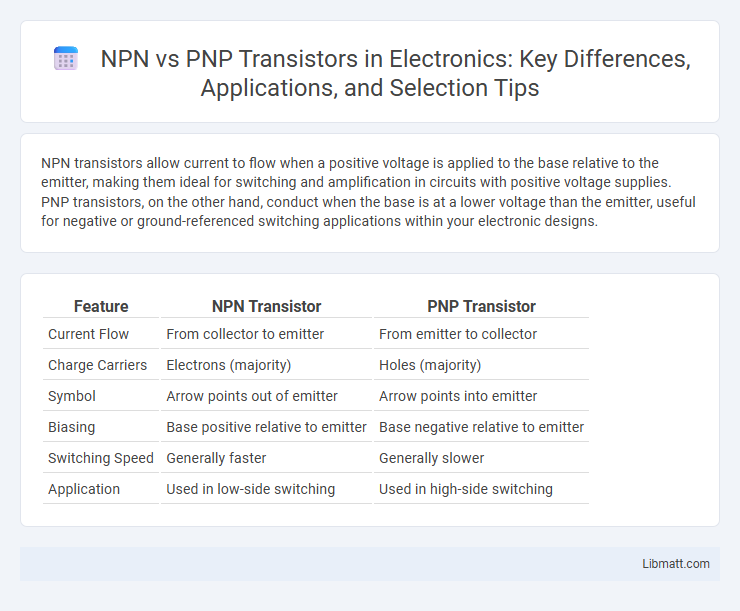NPN transistors allow current to flow when a positive voltage is applied to the base relative to the emitter, making them ideal for switching and amplification in circuits with positive voltage supplies. PNP transistors, on the other hand, conduct when the base is at a lower voltage than the emitter, useful for negative or ground-referenced switching applications within your electronic designs.
Table of Comparison
| Feature | NPN Transistor | PNP Transistor |
|---|---|---|
| Current Flow | From collector to emitter | From emitter to collector |
| Charge Carriers | Electrons (majority) | Holes (majority) |
| Symbol | Arrow points out of emitter | Arrow points into emitter |
| Biasing | Base positive relative to emitter | Base negative relative to emitter |
| Switching Speed | Generally faster | Generally slower |
| Application | Used in low-side switching | Used in high-side switching |
Introduction to NPN and PNP Transistors
NPN and PNP transistors are types of bipolar junction transistors (BJTs) essential for amplifying or switching electronic signals. An NPN transistor consists of a layer of P-type semiconductor between two N-type layers, while a PNP transistor has a layer of N-type semiconductor sandwiched between two P-type layers. Both transistors operate by controlling current flow through their respective base-emitter junctions, with NPN transistors requiring a positive base voltage and PNP transistors relying on a negative base voltage relative to the emitter.
Basic Structure and Symbol Differences
NPN transistors consist of a layer of p-type semiconductor sandwiched between two n-type layers, while PNP transistors have an n-type layer between two p-type layers. The symbol for an NPN transistor features an arrow pointing outward from the emitter, indicating current flow from the emitter to the base, whereas the PNP symbol has the arrow pointing inward toward the emitter, reflecting current flow from base to emitter. These structural and symbolic differences are essential for identifying transistor types and understanding their polarity and current direction in circuits.
Working Principle of NPN Transistor
The working principle of an NPN transistor relies on current flow through three layers of semiconductor material: the emitter, base, and collector. When a small current is applied to the base-emitter junction, it allows a much larger current to flow from the collector to the emitter. This transistor operation is based on the movement of electrons from the emitter (n-type) to the collector (n-type) through the thin, lightly doped p-type base, enabling electrical amplification and switching functions.
Working Principle of PNP Transistor
The working principle of a PNP transistor involves current flow through two layers of P-type semiconductor separated by an N-type layer, where the majority charge carriers are holes. When a small current is applied to the base (N-type), it allows a larger current to flow from the emitter (P-type) to the collector (P-type), enabling amplification and switching functions. The emitter-base junction is forward-biased, and the collector-base junction is reverse-biased, controlling the transistor's operation.
Key Differences between NPN and PNP Transistors
NPN transistors have electrons as majority carriers, while PNP transistors use holes, affecting their current flow and switching characteristics. NPN transistors conduct when a positive voltage is applied to the base relative to the emitter, whereas PNP transistors conduct when the base is more negative than the emitter. Voltage polarities and biasing requirements differ, making NPN types preferred for positive ground circuits and PNP for negative ground configurations.
Applications of NPN Transistors
NPN transistors are widely used in switching and amplification applications due to their ability to efficiently conduct current when a positive voltage is applied to the base. These transistors are common in digital circuits, signal amplification, and power regulation systems because of their fast switching speed and higher electron mobility. Your electronic projects can benefit from NPN transistors when designing circuits that require reliable switching or amplification under varying voltage conditions.
Applications of PNP Transistors
PNP transistors are commonly utilized in switching applications where current flow needs to be controlled on the positive side of the circuit, such as in high-side switches. They play a crucial role in amplifier circuits, particularly in complementary push-pull configurations, which improve efficiency and reduce distortion. Your choice to use PNP transistors is essential when designing circuits that require current sourcing or control from the positive power rail.
Choosing Between NPN and PNP for Circuits
Choosing between NPN and PNP transistors depends on the circuit's voltage polarity and signal flow requirements; NPN transistors are typically used when the load is connected to the positive voltage and the transistor switches the ground side, offering faster electron mobility and higher efficiency. PNP transistors are preferred when the load is connected to ground and the switching occurs on the positive side, which suits circuits powered by negative polarity or for high-side switching. Your decision should consider switching speed, voltage levels, and the transistor's role in controlling current direction within the circuit design.
Common Circuit Configurations and Examples
NPN and PNP transistors are widely used in common emitter, common collector, and common base configurations with distinct biasing and current flow directions. NPN transistors typically serve as low-side switches in circuits, allowing current to flow from collector to emitter when a positive base voltage is applied relative to the emitter. PNP transistors function as high-side switches, conducting current from emitter to collector when the base is at a lower voltage than the emitter, commonly seen in amplifier circuits and push-pull stages.
Summary: NPN vs PNP Transistor Comparison
NPN and PNP transistors differ primarily in the direction of current flow and the type of charge carriers; NPN transistors conduct when electrons move from the emitter to the collector, while PNP transistors conduct through hole movement in the opposite direction. NPN transistors are generally preferred for faster switching and higher efficiency due to electron mobility, whereas PNP transistors are commonly used in low-side switch applications. Understanding the polarity and current flow in your circuit helps you select the appropriate transistor type for optimal performance.
NPN vs PNP Transistor Infographic

 libmatt.com
libmatt.com